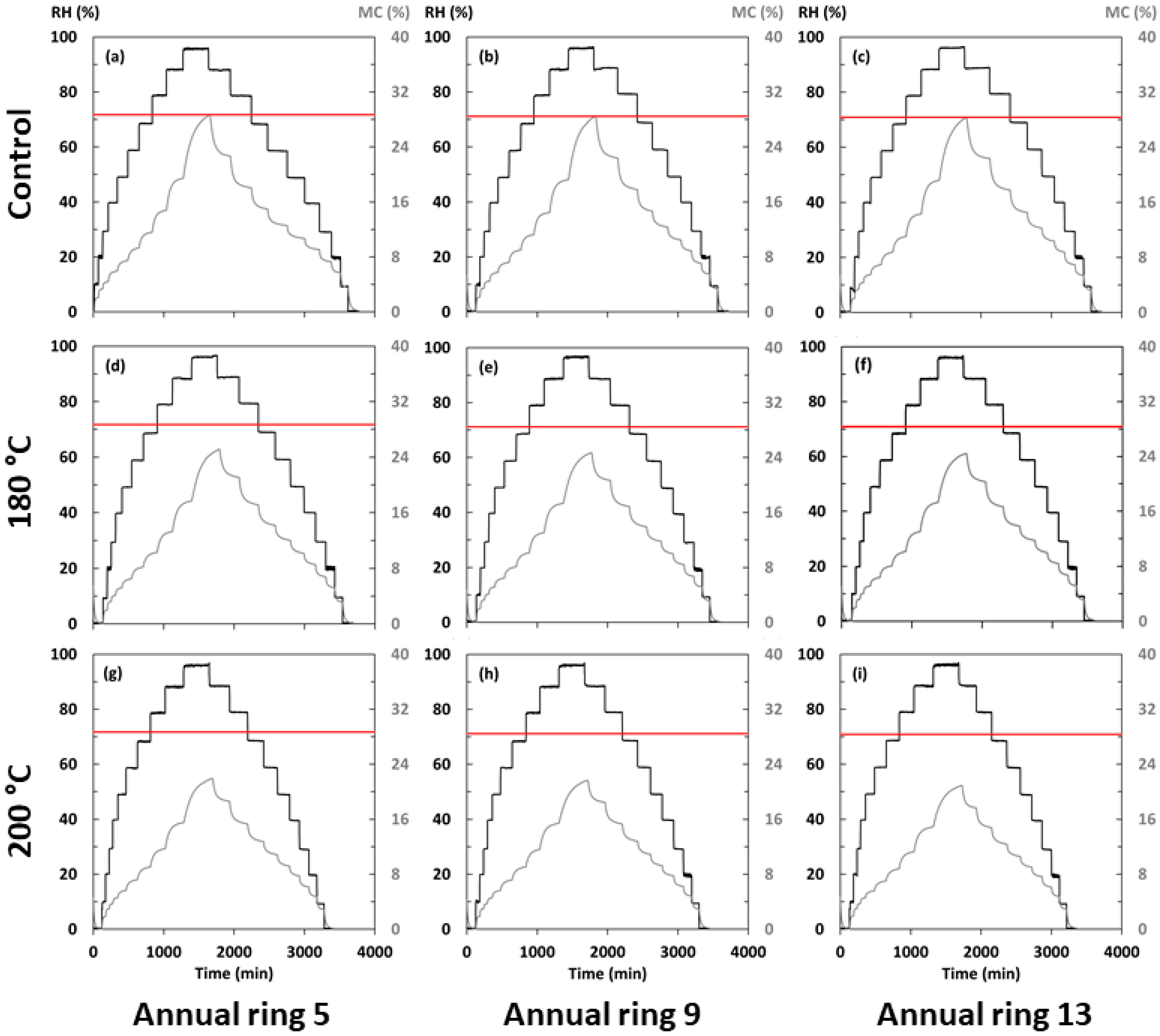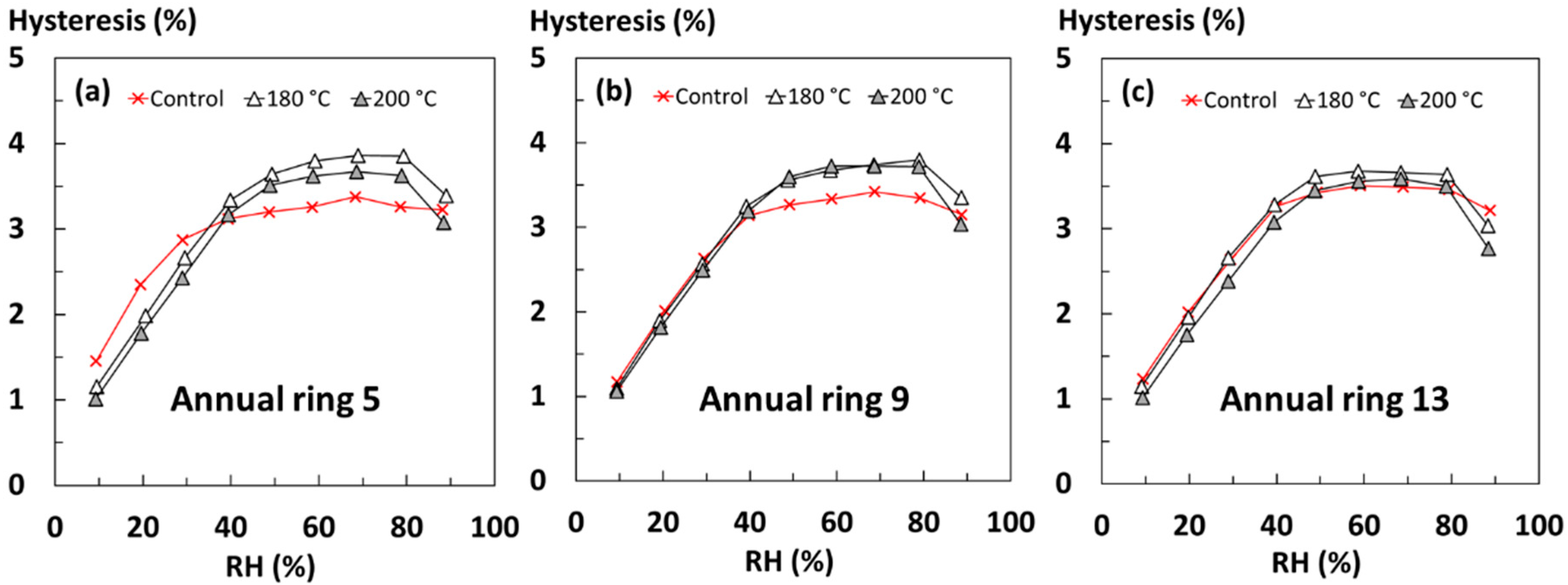Studying the Impact of Heat Treatments and Distance from Pith on the Sorption Behavior of Tree of Heaven Wood (Ailanthus altissima (Mill.) Swingle)
Abstract
:1. Introduction
2. Materials and Methods
2.1. Wood Material
2.2. Heat-Treatment
2.3. Dynamic Vapor Sorption Tests
3. Results and Discussion
4. Conclusions
Author Contributions
Funding
Data Availability Statement
Acknowledgments
Conflicts of Interest
References
- Zelinka, S.; Thybring, E.E.; Glass, S. Interpreting Dynamic Vapor Sorption (DVS) Measurements: Why Wood Science Needs to Hit the Reset Button. In Proceedings of the World Conference on Timber Engineering, Santiago, Chile, 9–12 August 2021; p. EPFT0101. [Google Scholar]
- Fredriksson, M.; Thybring, E.E. Scanning or Desorption Isotherms? Characterising Sorption Hysteresis of Wood. Cellulose 2018, 25, 4477–4485. [Google Scholar] [CrossRef]
- Simpson, W. Sorption Theories Applied to Wood. Wood Fiber Sci. 1980, 3, 183–195. [Google Scholar]
- Skaar, C. Wood-Water Relations; Springer: Berlin/Heidelberg, Germany, 1988. [Google Scholar]
- Thybring, E.E.; Fredriksson, M.; Zelinka, S.L.; Glass, S.V. Water in Wood: A Review of Current Understanding and Knowledge Gaps. Forests 2022, 13, 2051. [Google Scholar] [CrossRef]
- Hill, C.A.S.; Ramsay, J.; Keating, B.; Laine, K.; Rautkari, L.; Hughes, M.; Constant, B. The Water Vapour Sorption Properties of Thermally Modified and Densified Wood. J. Mater Sci. 2012, 47, 3191–3197. [Google Scholar] [CrossRef]
- Hill, C.; Altgen, M.; Rautkari, L. Thermal Modification of Wood—A Review: Chemical Changes and Hygroscopicity. J. Mater. Sci. 2021, 56, 6581–6614. [Google Scholar] [CrossRef]
- Zelinka, S.L.; Glass, S.V.; Thybring, E.E. Myth versus Reality: Do Parabolic Sorption Isotherm Models Reflect Actual Wood–Water Thermodynamics? Wood Sci Technol. 2018, 52, 1701–1706. [Google Scholar] [CrossRef]
- Brus, R.; Pötzelsberger, E.; Lapin, K.; Brundu, G.; Orazio, C.; Straigyte, L.; Hasenauer, H. Extent, Distribution and Origin of Non-Native Forest Tree Species in Europe. Scand. J. For. Res. 2019, 34, 533–544. [Google Scholar] [CrossRef]
- Kardos, J. Hazai Termőhelyen Fejlődő Ecetfa Fájának Vizsgálata; Fatechnológia Tanszék: Sopron, Hungary, 1988. [Google Scholar]
- Alden, H.A. Hardwood of North America—Ailanthus altissima; United States Department of Agriculture, Forest Service, Forest Products Laboratory: Madison, WI, USA, 1995.
- Varga, A. A Bálványfa (Ailanthus altissima) Vizsgálata; Fatechnológia Tanszék: Sopron, Hungary, 1995. [Google Scholar]
- Várhegyi, G. Ailanthus altissima (Bálványfa) Fájának Fizikai-Mechanikai Vizsgálata; Fatechnológia Tanszék: Sopron, Hungary, 1995. [Google Scholar]
- Molnár, S.; Bariska, M. Magyarország Ipari Fái; Szaktudás Kiadó Ház Zrt: Budapest, Hungary, 2002. [Google Scholar]
- Németh, R.; Bak, M.; Fehér, S.; Horváth, N.; Komán, S.; Eső, I.; Vörös, Á.; Horváth, D.; Báder, M. Wood Research of the Tree-of-Heaven (Ailanthus altissima) at the Institute of Wood Science in Sopron. In 9th Hardwood Proceedings Part I. With Special Focus on “An Underutilized Resource: Hardwood Oriented Research”, Sopron, Hungary, 21–22 October 2020; University of Sopron Press: Sopron, Hungary, 2020; Volume 9, pp. 200–206. [Google Scholar]
- Panayotov, P.; Kalmukov, K.; Panayotov, M. Biological and Wood Propoerties of Ailanthus altissima (Mill.) Swingle. For. Ideas. 2011, 17, 122–130. [Google Scholar]
- Wagenführ, R. Holzatlas; Fachbuchverlag: Leipzig, Germany, 2007. [Google Scholar]
- Brandner, R.; Schickhofer, G. The Mechanical Potential of the Tree-of-Heaven (Ailanthus altissima). Holztechnologie 2013, 54, 5–11. [Google Scholar]
- Gyuricsek, T.; Horváth, N.; Németh, R. Effect of Heat Treatments on Selected Properties of Tree-of-Heaven (Ailanthus altissima). In Proceedings of the “IAWS Plenary Meeting 2014—Sopron (Hungary)—Vienna (Austria)”—Eco-Efficient Resource Wood with Special Focus on Hardwoods. Sopron & Vienna, Sopron, Hungary, 15–18 September 2014; University of West Hungary Press: Sopron, Hungary, 2014; pp. 63–64, ISBN 978-963-334-191-9. [Google Scholar]
- Fehér, S.; Komán, S. A Bálványfa (Ailanthus altissima) Faipari És Energetikai Célú Alkalmazhatósága. In Alföldi Erdőkért Egyesület Kutatói Nap XXII: Tudományos Eredmények a Gyakorlatban; Alföldi Erdőkért Egyesület: Kecskemét, Hungary, 2014; pp. 64–69. [Google Scholar]
- Terzopoulou, P.; Kamperidou, V.; Barboutis, I. Utilization Potential of Tree-of-Heaven Species Biomass—A Review. Appl. Sci. 2023, 13, 9185. [Google Scholar] [CrossRef]
- Soler, J.; Izquierdo, J. The Invasive Ailanthus altissima: A Biology, Ecology, and Control Review. Plants 2024, 13, 931. [Google Scholar] [CrossRef]
- Bartha, D. Black List. Invasive Tree and Shrub Species of Hungary; University of Sopron Press: Sopron, Hungary, 2020. [Google Scholar]
- Kasson, M.T.; Davis, M.D.; Davis, D.D. The Invasive Ailanthus altissima in Pennsylvania: A Case Study Elucidating Species Introduction, Migration, Invasion, and Growth Patterns in the Northeastern US. Northeast. Nat. 2013, 20, 1–60. [Google Scholar] [CrossRef]
- Barboutis, I.; Kamperidou, V. Impact of Heat Treatment on the Quality of Tree-of-Heaven Wood. Drv. Ind. 2019, 70, 351–358. [Google Scholar] [CrossRef]
- Olek, W.; Bonarski, J. Texture Changes in Thermally Modified Wood. Arch. Metall. Mater. 2008, 53, 207–211. [Google Scholar]
- Bak, M.; Németh, R. Crack Formation during Oil-Heat-Treatment in Relation with the Initial Moisture Content. In Proceedings of the 8th European Conference on Wood Modification, Helsinki, Finland, 26–27 October 2015; pp. 334–337. [Google Scholar]
- Miao, X.; Chen, H.; Lang, Q.; Bi, Z.; Zheng, X.; Pu, J. Characterization of Ailanthus altissima Veneer Modified by Urea-Formaldehyde Pre-Polymer with Compression Drying. BioResources 2014, 9, 5928–5939. [Google Scholar] [CrossRef]
- Qian, J.; Gao, J.; He, Z.; Yi, S. Self-Shrinking Ailanthus altissima Substrate Obtained by Ultrasonic-Assisted Treatment: Density and Pore Structure Characteristics. Ind. Crops Prod. 2022, 175, 114221. [Google Scholar] [CrossRef]
- Bytner, O.; Laskowska, A.; Drożdżek, M.; Kozakiewicz, P.; Zawadzki, J. Evaluation of the Dimensional Stability of Black Poplar Wood Modified Thermally in Nitrogen Atmosphere. Materials 2021, 14, 1491. [Google Scholar] [CrossRef] [PubMed]
- Cao, Y.; Lu, J.; Huang, R.; Jiang, J. Increased Dimensional Stability of Chinese Fir through Steam-Heat Treatment. Eur. J. Wood Prod. 2012, 70, 441–444. [Google Scholar] [CrossRef]
- Humar, M.; Repič, R.; Kržišnik, D.; Lesar, B.; Cerc Korošec, R.; Brischke, C.; Emmerich, L.; Rep, G. Quality Control of Thermally Modified Timber Using Dynamic Vapor Sorption (DVS) Analysis. Forests 2020, 11, 666. [Google Scholar] [CrossRef]
- Jiang, X.; Van den Bulcke, J.; De Ligne, L.; Van Acker, J. Biological Durability and Moisture Dynamics of Untreated and Thermally Modified Poplar. Eur. J. Wood Prod. 2024, 82, 703–715. [Google Scholar] [CrossRef]
- Tjeerdsma, B.F.; Boonstra, M.; Pizzi, A.; Tekely, P.; Militz, H. Characterisation of Thermally Modified Wood: Molecular Reasons for Wood Performance Improvement. Holz als Roh-und Werkstoff 1998, 56, 149–153. [Google Scholar] [CrossRef]
- Li, T.; Cheng, D.; Avramidis, S.; Wålinder, M.E.P.; Zhou, D. Response of Hygroscopicity to Heat Treatment and Its Relation to Durability of Thermally Modified Wood. Constr. Build. Mater. 2017, 144, 671–676. [Google Scholar] [CrossRef]
- Akgul, M.; Tozluoglu, A. Some Chemical and Morphological Properties of Juvenile Woods from Beech (Fagus orientalis L.) and Pine (Pinus nigra A.) Plantations. Trends Appl. Sci. Res. 2009, 4, 116–125. [Google Scholar] [CrossRef]
- Hill, C.; Altgen, M.; Penttilä, P.; Rautkari, L. Review: Interaction of Water Vapour with Wood and Other Hygro-Responsive Materials. J. Mater. Sci. 2024, 59, 7595–7635. [Google Scholar] [CrossRef]
- Vilpponen, E.; Komán, S.; Bejo, L. Reinforcing the Mechanical Properties of Poplar LVL with Hardwood Veneer Layers, Part I.: Non-Destructive Testing and Modelling the Elastic Properties. Faipar 2014, 62, 24–30. [Google Scholar] [CrossRef] [PubMed]
- Danihelová, A.; Čulík, M.; Danihelová, Z. Assessment of Properties of Ailanthus Wood for Xylophone Bars | Hodnotenie Vlastností Dreva Pajaseňa Žliazkatého Pre Xylofónové Doštičky. Akustika 2015, 24, 42–49. [Google Scholar]
- Gyuricsek, T. Bálványfa Fatestének Komplex Faanyagtudományi Vizsgálatai (Complex Analysis of Xylem of Tree of Heaven). Bachelor’s Thesis, University of West Hungary, Sopron, Hungary, 2015. [Google Scholar]
- Obataya, E.; Tomita, B. Hygroscopicity of Heat-Treated Wood, 2: Reversible and Irreversible Reductions in the Hygroscopicity of Wood Due to Heating. Mokuzai Gakkaishi 2002, 48, 288–295. [Google Scholar]
- Kržišnik, D.; Humar, M.; Maks, M. The Dynamic Water Vapour Sorption Behaviour of the Invasive Alien Species in Slovenia. In 9th Hardwood Proceedings Part I. With Special Focus on “An Underutilized Resource: Hardwood Oriented Research”, Sopron, Hungary, 21–22 October 2020; University of Sopron Press: Sopron, Hungary, 2020; Volume 9, pp. 149–152. [Google Scholar]
- Vahtikari, K.; Rautkari, L.; Noponen, T.; Lillqvist (née Laine), K.; Hughes, M. The Influence of Extractives on the Sorption Characteristics of Scots Pine (Pinus sylvestris L.). J. Mater. Sci. 2017, 52, 10840–10852. [Google Scholar] [CrossRef]
- Xie, Y.; Hill, C.A.S.; Xiao, Z.; Mai, C.; Militz, H. Dynamic Water Vapour Sorption Properties of Wood Treated with Glutaraldehyde. Wood Sci. Technol. 2011, 45, 49–61. [Google Scholar] [CrossRef]





| Temperature | Annual Ring | EMC95%RH (%) | t95%RH (min) | tEMC/2 (min) | t10%MC (min) | Total Running Time (min) |
|---|---|---|---|---|---|---|
| Control | 5 | 28.69 | 1656 | 922 | 661 | 3774 |
| 9 | 28.46 | 1830 | 1077 | 787 | 3712 | |
| 13 | 28.35 | 1792 | 1081 | 776 | 3711 | |
| 180 | 5 | 25.14 | 1791 | 977 | 804 | 3689 |
| 9 | 24.70 | 1771 | 954 | 826 | 3596 | |
| 13 | 24.44 | 1774 | 970 | 849 | 3592 | |
| 200 | 5 | 21.92 | 1692 | 872 | 831 | 3411 |
| 9 | 21.67 | 1717 | 896 | 860 | 3441 | |
| 13 | 20.92 | 1724 | 887 | 865 | 3349 |
Disclaimer/Publisher’s Note: The statements, opinions and data contained in all publications are solely those of the individual author(s) and contributor(s) and not of MDPI and/or the editor(s). MDPI and/or the editor(s) disclaim responsibility for any injury to people or property resulting from any ideas, methods, instructions or products referred to in the content. |
© 2024 by the authors. Licensee MDPI, Basel, Switzerland. This article is an open access article distributed under the terms and conditions of the Creative Commons Attribution (CC BY) license (https://creativecommons.org/licenses/by/4.0/).
Share and Cite
Fodor, F.; Emmerich, L.; Horváth, N.; Németh, R.; Hofmann, T. Studying the Impact of Heat Treatments and Distance from Pith on the Sorption Behavior of Tree of Heaven Wood (Ailanthus altissima (Mill.) Swingle). Forests 2024, 15, 1223. https://doi.org/10.3390/f15071223
Fodor F, Emmerich L, Horváth N, Németh R, Hofmann T. Studying the Impact of Heat Treatments and Distance from Pith on the Sorption Behavior of Tree of Heaven Wood (Ailanthus altissima (Mill.) Swingle). Forests. 2024; 15(7):1223. https://doi.org/10.3390/f15071223
Chicago/Turabian StyleFodor, Fanni, Lukas Emmerich, Norbert Horváth, Róbert Németh, and Tamás Hofmann. 2024. "Studying the Impact of Heat Treatments and Distance from Pith on the Sorption Behavior of Tree of Heaven Wood (Ailanthus altissima (Mill.) Swingle)" Forests 15, no. 7: 1223. https://doi.org/10.3390/f15071223





